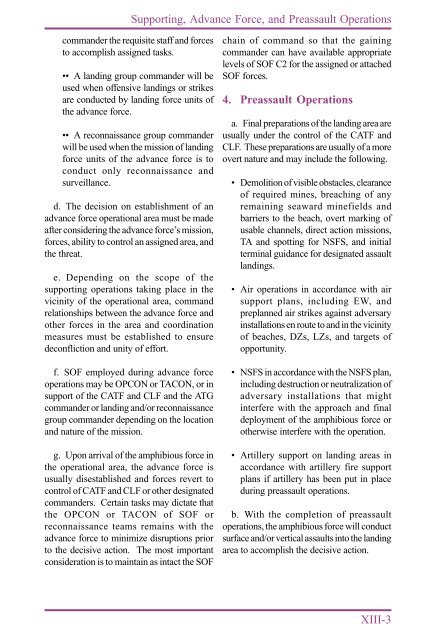Joint Doctrine for Amphibious Operations - Historic Naval Ships ...
Joint Doctrine for Amphibious Operations - Historic Naval Ships ...
Joint Doctrine for Amphibious Operations - Historic Naval Ships ...
- No tags were found...
Create successful ePaper yourself
Turn your PDF publications into a flip-book with our unique Google optimized e-Paper software.
Supporting, Advance Force, and Preassault <strong>Operations</strong>commander the requisite staff and <strong>for</strong>cesto accomplish assigned tasks.•• A landing group commander will beused when offensive landings or strikesare conducted by landing <strong>for</strong>ce units ofthe advance <strong>for</strong>ce.•• A reconnaissance group commanderwill be used when the mission of landing<strong>for</strong>ce units of the advance <strong>for</strong>ce is toconduct only reconnaissance andsurveillance.d. The decision on establishment of anadvance <strong>for</strong>ce operational area must be madeafter considering the advance <strong>for</strong>ce’s mission,<strong>for</strong>ces, ability to control an assigned area, andthe threat.e. Depending on the scope of thesupporting operations taking place in thevicinity of the operational area, commandrelationships between the advance <strong>for</strong>ce andother <strong>for</strong>ces in the area and coordinationmeasures must be established to ensuredeconfliction and unity of ef<strong>for</strong>t.f. SOF employed during advance <strong>for</strong>ceoperations may be OPCON or TACON, or insupport of the CATF and CLF and the ATGcommander or landing and/or reconnaissancegroup commander depending on the locationand nature of the mission.g. Upon arrival of the amphibious <strong>for</strong>ce inthe operational area, the advance <strong>for</strong>ce isusually disestablished and <strong>for</strong>ces revert tocontrol of CATF and CLF or other designatedcommanders. Certain tasks may dictate thatthe OPCON or TACON of SOF orreconnaissance teams remains with theadvance <strong>for</strong>ce to minimize disruptions priorto the decisive action. The most importantconsideration is to maintain as intact the SOFchain of command so that the gainingcommander can have available appropriatelevels of SOF C2 <strong>for</strong> the assigned or attachedSOF <strong>for</strong>ces.4. Preassault <strong>Operations</strong>a. Final preparations of the landing area areusually under the control of the CATF andCLF. These preparations are usually of a moreovert nature and may include the following.• Demolition of visible obstacles, clearanceof required mines, breaching of anyremaining seaward minefields andbarriers to the beach, overt marking ofusable channels, direct action missions,TA and spotting <strong>for</strong> NSFS, and initialterminal guidance <strong>for</strong> designated assaultlandings.• Air operations in accordance with airsupport plans, including EW, andpreplanned air strikes against adversaryinstallations en route to and in the vicinityof beaches, DZs, LZs, and targets ofopportunity.• NSFS in accordance with the NSFS plan,including destruction or neutralization ofadversary installations that mightinterfere with the approach and finaldeployment of the amphibious <strong>for</strong>ce orotherwise interfere with the operation.• Artillery support on landing areas inaccordance with artillery fire supportplans if artillery has been put in placeduring preassault operations.b. With the completion of preassaultoperations, the amphibious <strong>for</strong>ce will conductsurface and/or vertical assaults into the landingarea to accomplish the decisive action.XIII-3
















